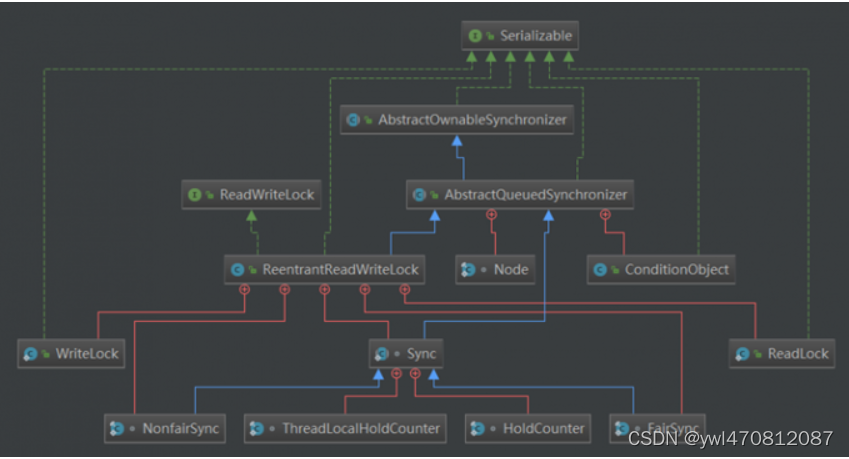概述
ReentrantReadWriteLock维护了一对相关的锁,它们分别是共享readLock和独占writeLock。关于共享读锁和排他写锁的概念其实很好理解。所谓共享读锁就是一个线程读的时候,其它线程也可以来读(共享),但是不能来写。排他写锁是指一个线程在写的时候,其它线程不能来写或读(排他)。除了这个特点之外,ReentrantReadWriteLock还有一个特点就是可重入的。它和ReentrantLock一样都是支持Condition的。而且ReentrantReadWerite还支持锁降级,即允许将写锁降级为读锁。
简单使用
最最基础的用法如下:
ReentrantReadWriteLock lock=new ReentrantReadWriteLock();public void read(){lock.readLock().lock();//需要加读锁的操作lock.readLock().unlock();}public void write(){lock.writeLock().lock();//需要加写锁的操作lock.writeLock().unlock();}ReentrantReadWriteLock无非就是这几种情况,读读共享,写写互斥,读写互斥,写读互斥。
下面我们就以这个最基础的用法,来分析一下其内部的原理
源码分析
继承体系

共享读锁的实现原理分析#
lock方法#
- 首先进入调用具体的实现
-
public void lock() {sync.acquireShared(1);} - 然后调用了这个方法
public final void acquireShared(int arg) { if (tryAcquireShared(arg) < 0) doAcquireShared(arg); }其中int tryAcquireShared(int unused)的具体实现如下:
protected final int tryAcquireShared(int unused) {/** Walkthrough:* 1. If write lock held by another thread, fail.* 2. Otherwise, this thread is eligible for* lock wrt state, so ask if it should block* because of queue policy. If not, try* to grant by CASing state and updating count.* Note that step does not check for reentrant* acquires, which is postponed to full version* to avoid having to check hold count in* the more typical non-reentrant case.* 3. If step 2 fails either because thread* apparently not eligible or CAS fails or count* saturated, chain to version with full retry loop.*/Thread current = Thread.currentThread();int c = getState();//持有写锁的线程可以获取读锁,如果获取锁的线程不是当前线程,则返回-1if (exclusiveCount(c) != 0 &&getExclusiveOwnerThread() != current)return -1;int r = sharedCount(c);//获取共享读锁的数量if (!readerShouldBlock() &&r < MAX_COUNT &&compareAndSetState(c, c + SHARED_UNIT)) {if (r == 0) {//如果首次获取锁,则初始化firstReader和firstReaderHoldCountfirstReader = current;firstReaderHoldCount = 1;} else if (firstReader == current) {//如果当前线程是首次获取读锁的线程firstReaderHoldCount++;} else {//更新HoldCounterHoldCounter rh = cachedHoldCounter;if (rh == null || rh.tid != getThreadId(current))cachedHoldCounter = rh = readHolds.get();else if (rh.count == 0)readHolds.set(rh);rh.count++;}return 1;}return fullTryAcquireShared(current);}整个函数的工作流程如下:
- 如果写锁已经被持有了,但是持有写锁的不是当前写出,那么就直接返回-1(体现写锁的排他性).
- 如果在尝试获取锁是不需要阻塞等待(由锁的公平性决定),并且读锁的共享计数小于最大值,那么就直接通过CAS更新读锁数量,获取读锁。
- 如果第二步执行失败了,那么就会调用
fullTryAcquireShared(current)
fullTryAcquireShared(current)的具体实现如下:
final int fullTryAcquireShared(Thread current) {/** This code is in part redundant with that in* tryAcquireShared but is simpler overall by not* complicating tryAcquireShared with interactions between* retries and lazily reading hold counts.*/HoldCounter rh = null;for (;;) { //自旋int c = getState();if (exclusiveCount(c) != 0) { //写锁已经被持有了if (getExclusiveOwnerThread() != current) //持有写锁的不是单线程return -1; //其它线程持有读锁后,就不能在获取写锁了// else we hold the exclusive lock; blocking here// would cause deadlock.} else if (readerShouldBlock()) {//由公平性决定需要阻塞// Make sure we're not acquiring read lock reentrantlyif (firstReader == current) { // assert firstReaderHoldCount > 0;} else {//更新锁计数(可重入的体现)if (rh == null) {rh = cachedHoldCounter;if (rh == null || rh.tid != getThreadId(current)) {rh = readHolds.get();if (rh.count == 0)//如果当前线程的持有读锁数为0,那么就没必要使用计数器,直接移除readHolds.remove();}}if (rh.count == 0)return -1;}}if (sharedCount(c) == MAX_COUNT) //如果读锁的数量超过最大值了throw new Error("Maximum lock count exceeded");if (compareAndSetState(c, c + SHARED_UNIT)) { //CAS更新读锁数量if (sharedCount(c) == 0) {//首次获取读锁firstReader = current;firstReaderHoldCount = 1;} else if (firstReader == current) {//当前线程是首次获取读锁的线程,直接更新持有数firstReaderHoldCount++;} else {//当前线程是后来共享读锁的线程if (rh == null)rh = cachedHoldCounter;if (rh == null || rh.tid != getThreadId(current))rh = readHolds.get();//更新为当前线程的计数器 else if (rh.count == 0)readHolds.set(rh);rh.count++;cachedHoldCounter = rh; // cache for release}return 1;}}}可以看出其实int fullTryAcquireShared(Thread current)也每什么特别,它的代码和int tryAcquireShared(int unused)差不多。只不过是增加了自旋重试,和“持有读锁数的延迟读取”
- 我们回到
void acquireShared(int arg)方法,如果tryAcquireShared(arg)获取读锁失败后,它调用的doAcquireShared(arg)又做了什么呢?
它的具体实现如下 -
private void doAcquireShared(int arg) {final Node node = addWaiter(Node.SHARED); //添加一个共享模式的Node到等待队列尾部boolean failed = true;try {boolean interrupted = false; //获取前驱节点for (;;) {final Node p = node.predecessor();if (p == head) {//如果前驱节点,尝试获取资源int r = tryAcquireShared(arg);if (r >= 0) {//获取成功,更新等待队列,并唤醒下一个等待的节点setHeadAndPropagate(node, r);p.next = null; // help GCif (interrupted)selfInterrupt();failed = false;return;}}if (shouldParkAfterFailedAcquire(p, node) && //检查获取失败后是否可以阻塞parkAndCheckInterrupt())interrupted = true;}} finally {if (failed)cancelAcquire(node);}}其实整个获取共享读锁的源码看下来,我们可以发现,AQS框架下,获取锁一般的流程就是首先尝试去直接获取,如果获取不到了,那么尝试自旋获取,如果还是获取不到,那么就去等待队列排队,排队的时候,如果发现自己是第二个那么就再次尝试获取锁,如果还是没获取到,那么就老老实实的在等待队列中park阻塞等待了。
我们通过源码,也可发现AQS框架下的锁,其实如果线程之间对锁的争用很低的时候,大多数时候直接就能拿到锁,几乎不需要排队,阻塞之类的,性能非常之高。
unlock方法
- 第一步还是调用具体的实现、
-
public void unlock() {sync.releaseShared(1);} - 具体的实现如下
-
public final boolean releaseShared(int arg) {if (tryReleaseShared(arg)) {doReleaseShared();return true;}return false;} - 首先来看
tryReleaseShared(arg) -
protected final boolean tryReleaseShared(int unused) {Thread current = Thread.currentThread();if (firstReader == current) { //如过当前线程是第一获取到读锁的线程// assert firstReaderHoldCount > 0;//直接更新线程持有数if (firstReaderHoldCount == 1)firstReader = null;elsefirstReaderHoldCount--;} else {HoldCounter rh = cachedHoldCounter;if (rh == null || rh.tid != getThreadId(current))rh = readHolds.get(); //获取当前线程的计数器int count = rh.count;if (count <= 1) {readHolds.remove();if (count <= 0)throw unmatchedUnlockException();}--rh.count;}for (;;) { //自旋int c = getState();int nextc = c - SHARED_UNIT;if (compareAndSetState(c, nextc)) //更新state// Releasing the read lock has no effect on readers,// but it may allow waiting writers to proceed if// both read and write locks are now free.return nextc == 0;}}我们从
tryReleaseShared(arg)的实现中可以看出,它的主要是去更新锁计数器和state。如果state为0的话,就返回true,否则就返回false。 - 我们回过头看,如果
tryReleaseShared(arg)返回true,即锁释放后state为0了,那么它会执行doReleaseShared();方法,它的具体实现如下: -
private void doReleaseShared() {/** Ensure that a release propagates, even if there are other* in-progress acquires/releases. This proceeds in the usual* way of trying to unparkSuccessor of head if it needs* signal. But if it does not, status is set to PROPAGATE to* ensure that upon release, propagation continues.* Additionally, we must loop in case a new node is added* while we are doing this. Also, unlike other uses of* unparkSuccessor, we need to know if CAS to reset status* fails, if so rechecking.*/for (;;) {Node h = head;if (h != null && h != tail) {int ws = h.waitStatus;if (ws == Node.SIGNAL) {if (!compareAndSetWaitStatus(h, Node.SIGNAL, 0))continue; // loop to recheck casesunparkSuccessor(h);}else if (ws == 0 &&!compareAndSetWaitStatus(h, 0, Node.PROPAGATE))continue; // loop on failed CAS}if (h == head) // loop if head changedbreak;}}这个方法的作用就是唤醒等待队列中线程,现在资源已经空闲了,等待的线程可以唤醒来获取锁了。
排他写锁的实现原理分析#
排他写锁的实现原理其实和ReentrantLock一致。我们只看几处和共享读锁不同的地方。
-
//公平锁实现 protected final boolean tryAcquire(int acquires) {final Thread current = Thread.currentThread();int c = getState();if (c == 0) {if (!hasQueuedPredecessors() && //判断当前线程是否还有前节点compareAndSetState(0, acquires)) {//CAS修改state//获取锁成功,设置锁的持有线程为当前线程setExclusiveOwnerThread(current);return true;}}else if (current == getExclusiveOwnerThread()) {//该线程之前已经拿到锁int nextc = c + acquires; //重入的体现if (nextc < 0)throw new Error("Maximum lock count exceeded");setState(nextc); //更新Statereturn true;}return false;}其实非公平锁的实现也差不多,只不过少了
!hasQueuedPredecessors()它不会去判断当前线程是否还有前驱节点,直接就开始获取锁了。unlock方法也差不多我就不赘述了。











)


类属性复制)


的最大消息大小配额。若要增加配额,请使用相应绑定元素上的 MaxReceivedMessageSize 属性...)

